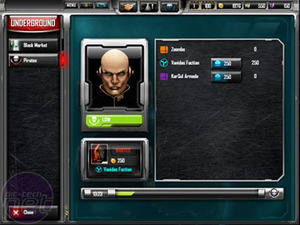Gameplay
As a game, Sins of a Solar Empire has no real campaign mode to speak of. Instead, there are either pre-generated or randomly generated scenarios that range in size from small to gargantuan. The small scenarios have a handful of planets around one star system and only one other opponent. Huge scenarios on the other hand can have over a hundred different planets orbiting around several different stars, with up to a dozen opponents.Stardock itself reckons at around 10 minutes of gameplay for each planet, so you're looking at a couple of hours play time just to complete the smaller scenarios. For the full-scale battles though, you'll probably want to build a stash of caffeine and chocolate in advance.
There are tutorials available to ease you in, but these are woefully short and don't capture the complicated nature of the game – nor do they explain the game mechanics in any real depth. The learning curve is quite steep, and without a campaign to expand on what you learn in the tutorials, you really are thrown in at the deep end. If you jump straight into an online game, expect to have your man parts handed to you on a plate in fairly short order.
Each game starts with a home world, a ship yard and some construction ships. First order of the day is to start gathering resources in true RTS style. There are three types of resource available: metal is gathered from asteroids, and is used to build ships and structures; crystal also comes from asteroids, and is used mainly for research. Where the game shows its 4X roots is that money comes from taxes gathered from all the planets that you control.
All of the activity takes place in an area around the planet called the gravity well. It's in this ring that all of your strategic structures will be built, and in which all combat finds a battlefield. Thankfully, the gravity well is really just a 2D disc so it's easy to keep track of your structures and ships in the heat of battle.
There are three types of ship available to build. Frigates are workhorse ships and can range from scouts to powerful warships, Cruisers are larger than frigates but are more specialised and tend to take a support role, while the Capital Ships are the real powerhouses with serious firepower and the capability to colonise planets. Each capital ship can also have a number of fighter and bomber squadrons which adds to its firepower further. The number of capital ships you can build is limited by the number of elite crews available, which in turn is dependent on your research.
In addition to the traditional RTS military research tree featuring new ship types and weapon technologies, there are also the more 4X-oriented civilian research trees for each race. These concentrate around protection of planets, increased mining functions and enhanced trade abilities. Each race has its own distinct set of research trees and, although they share mostly common features, there are a few unique abilities available to the different races.
Each planet also has one or more "phase lanes" to another planet that are only discovered once one of your ships has visited that planet. Travel along these phase lanes takes time, and if the bulk of your fleet is over the other side of the solar system, it could take several minutes to get to where they're needed. It's this aspect of the game which forces more long-term strategic thinking over the traditional RTS "build it and rush" thinking.
As well as the usual RTS goals of amassing a huge army and then going forth to beat the pulp out of any rivals, it’s also possible to set up cease fires or trade agreements with opponents – or even share information with them. Whether or not they agree to these agreements depends on your diplomatic relations – these can be improved by taking on missions such as donating resources or attacking a common enemy.
A black market also exists where you can buy and sell various resources and also set bounties on other players, which sets the thugs of the galaxy (the pirates) onto them. The pirates will carry on attacking this player until your money runs out, so it's a useful way of keeping one opponent out of your hair while you deal with another.
One innovation we liked is the way you keep track planets and ships. Because the game arena is so huge, it isn't really possible to use a mini-map to see what’s happening. Instead, the game has an "empire tree" along the left side of the screen that lists all your planets and all the ships they have in orbit. Importantly, it also shows any opponent's ships that come into the vicinity so you can quickly see which of your planets are under attack.

MSI MPG Velox 100R Chassis Review
October 14 2021 | 15:04













Want to comment? Please log in.